
Zoo emergency response teams, also called emergency weapons teams, lethal restraint teams or firearms emergency response teams, are teams that respond when zoo animals escape their enclosure and threaten zoo visitors and employees.

Zoo emergency response teams, also called emergency weapons teams, lethal restraint teams or firearms emergency response teams, are teams that respond when zoo animals escape their enclosure and threaten zoo visitors and employees.
Emergency response teams are responsible for the capture of escaped animals. Goals include: (listed in order of priority)
Emergency response teams are not full-time but are typically composed of zoo employees who have received special weapons training from a police agency. They are trained to use deadly force, but only as a last resort when the escaped animal is threatening the life of a human being. Zoos frequently perform training drills in order to keep the team up to date and ready for a real animal escape. [1]
When an animal escapes, guests are immediately evacuated from the area and escorted to secured buildings on zoo grounds by the zoo’s emergency response team (veterinarians armed with tranquilizer equipment, zoo firearms team and animal management staff). The zoo’s perimeter is sealed off for safety and is usually reopened after the animal is secured. [2]
Australian zoos use a set of standard emergency radio codes for dealing with escaped animals. [3] Many zoos in America have a similar policy. [4]
Many zoos created or enhanced their emergency response teams following a gorilla attack at the Dallas Zoo in 2004.
On February 24, 2007, an emergency response team at the Denver Zoo shot and killed a jaguar which had attacked a zookeeper. [5] The zookeeper later died from her injuries.
On May 28, 2016, a 4-year-old boy climbed through a public barrier at Gorilla World at around 4pm at the Cincinnati Zoo & Botanical Garden and fell into the exhibit’s moat. The two female gorillas in the exhibit were recalled immediately, but the third, a male named Harambe, remained in the yard with the child. The Zoo’s Dangerous Animal Response Team responded to the situation by fatally shooting the gorilla. [6]
The following equipment is used by most zoos in the recapture of an escaped animal. [7]
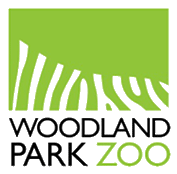
Woodland Park Zoo is a wildlife conservation organization and zoological garden located in the Phinney Ridge neighborhood of Seattle, Washington, United States. The zoo is the recipient of over 65 awards across multiple categories. The zoo has around 900 animals from 250 species and the zoo has over 1 million visitors a year.

The Berlin Zoological Garden is the oldest surviving and best-known zoo in Germany. Opened in 1844, it covers 35 hectares and is located in Berlin's Tiergarten. With about 1,380 different species and over 20,200 animals, the zoo presents one of the most comprehensive collections of species in the world.

The Los Angeles Zoo and Botanical Gardens is a 133-acre (54 ha) zoo founded in 1966 and located in Los Angeles, California, United States. The city of Los Angeles owns the zoo, its land and facilities, and the animals.

The Oklahoma City Zoo and Botanical Garden is a zoo and botanical garden located in Oklahoma City's Adventure District in northeast Oklahoma City, Oklahoma.

The Wilder Institute/Calgary Zoo is located in Bridgeland, Calgary, Alberta, Canada, just east of the city's downtown and adjacent to the Inglewood and East Village neighborhoods. It is accessible via Calgary's C-Train light rail system, by car via Memorial Drive, and by bicycle and footpath via the Bow River pathway. A large portion of the zoo is located on St. George's Island in the Bow River.
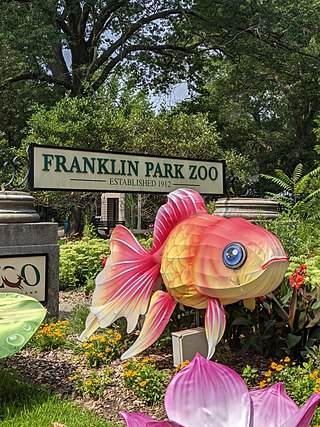
The Franklin Park Zoo is a 72-acre (290,000 m2) zoo located in Boston, Massachusetts and is currently operated by Zoo New England, which also operates the Stone Zoo in Stoneham, Massachusetts. The zoo is located in the northeast portion of Franklin Park, Boston's largest park and the last component of the city's famed Emerald Necklace.
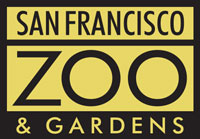
The San Francisco Zoo is a 100-acre (40 ha) zoo located in the southwestern corner of San Francisco, California, between Lake Merced and the Pacific Ocean along the Great Highway. The SF Zoo is a public institution, managed by the non-profit San Francisco Zoological Society, a 501(c)(3) organization. under a public-private partnership since 1993, receives $4.2 million annually from the city. As of 2016, the zoo housed more than one thousand individual animals, representing more than 250 species. It is noted as the birthplace of Koko the gorilla, and, from 1974 to 2016, the home of Elly, the oldest black rhinoceros in North America.
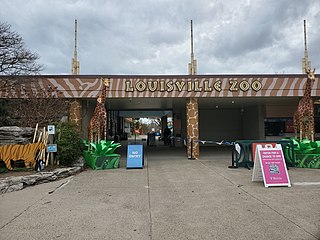
The Louisville Zoological Gardens, commonly known as the Louisville Zoo, is a 134-acre (54 ha) zoo in Louisville, Kentucky, situated in the city's Poplar Level neighborhood. Founded in 1969, the "State Zoo of Kentucky" currently exhibits over 1,200 animals in naturalistic and mixed animal settings representing both geographical areas and Biomes or habitats.

The Birmingham Zoo is a zoological park that opened in 1955 in Birmingham, Alabama, United States.

Dallas Zoo is a 106-acre (43 ha) zoo located 3 mi (5 km) south of downtown Dallas, Texas, in Marsalis Park. Established in 1888, it is the oldest and largest zoological park in Texas and is managed by the non-profit Dallas Zoological Society. It is home to over 2,000 animals representing 406 species. It is an accredited member of the Association of Zoos and Aquariums (AZA), and is a member of the World Association of Zoos and Aquariums (WAZA).
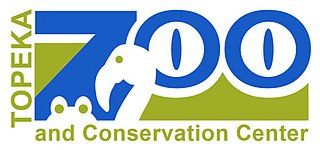
The Topeka Zoo is a medium-sized zoo in Topeka, Kansas in the United States. It is located within Gage Park, just off I-70 in the north central portion of the city. Despite its size, it houses over 300 animals in a number of exhibits, including one of the first indoor tropical rain forests in the United States. It is one of the most popular attractions in Topeka, with over 250,000 visitors a year.
The Zoo was a New Zealand observational documentary series, made by Greenstone TV, that followed the lives of Auckland Zoo's animals and zookeepers. The series explored the new arrivals and births of Auckland Zoo, to the fights, illnesses and mating rituals, how the animals are fed and how they live. The series' production crew were based full-time at the zoo, but the series also followed zookeepers overseas on zoo-related trips.

Paignton Zoo is a zoo in Paignton, Devon, England. The zoo was started as a private collection by avid animal collector and breeder, Herbert Whitley, in the grounds of his home Primley House. It was opened to the public on a number of occasions, originally as Primley Zoological Gardens, and closed twice due to disputes with the tax authorities. The commercialisation of the zoo came when animals and attractions were relocated from Chessington Zoo during World War II, and the site was named as Devon's Zoo and Circus

Seoul Grand Park (Korean: 서울대공원) or Gwacheon Seoul Grand Park (과천서울대공원) is a park complex to the south of Seoul, South Korea, in the city of Gwacheon. Opened on May 1 in 1984.

The Warsaw Zoological Garden, known simply as the Warsaw Zoo, is a scientific zoo located alongside the Vistula River in Warsaw, Poland. Opened in 1928, the zoo covers about 40 hectares in central Warsaw, and sees over 700,000 visitors annually, making it one of the most popular zoos in Poland. It is home to over 11,000 animals representing more than 500 species.
The Greater Vancouver Zoo is a 49-hectare (120-acre) privately-run zoo located in Aldergrove, British Columbia, Canada. The zoo was established in 1970 as the Vancouver Game Farm. Since then it has undergone two name changes, being briefly renamed as the Greater Vancouver Zoological Centre in 1995, before it adopted its present name in 1999. As of 2023, the zoo is home to 180 animals, representing over 100 different species, including several orphaned, rescued and otherwise non-releasable individuals. The zoo's mission statement is "to inspire appreciation of our ecosystems and support conservation efforts by engaging the community."
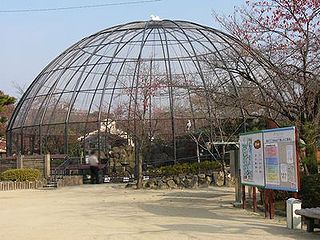
Kyoto City Zoo (京都市動物園) is a zoo located in Sakyō ward, Kyoto and was established in 1903, making it the second oldest zoo in the country after Ueno Zoo in Tokyo.
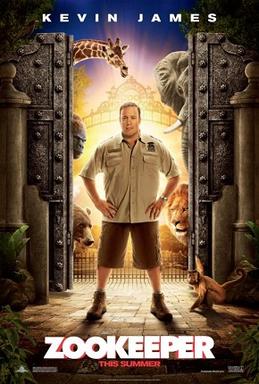
Zookeeper is a 2011 American fantasy comedy film directed by Frank Coraci, with a screenplay by Nick Bakay, Rock Reuben, Kevin James, Jay Scherick, and David Ronn, from a story by Scherick and Ronn, and produced by Todd Garner, James, Adam Sandler, Jack Giarraputo, and Walt Becker. The film stars James, Rosario Dawson, and Leslie Bibb with supporting roles by Ken Jeong, Donnie Wahlberg, Joe Rogan, Nat Faxon, and Tom Woodruff Jr., alongside the voices of Cher, Nick Nolte, Sandler, Sylvester Stallone, Judd Apatow, Jim Breuer, Jon Favreau, Faizon Love, Richie Minervini, Maya Rudolph, and Bas Rutten. It is about an unlucky zookeeper and the talking animals at his zoo who break their silence to help him find love.
In the United States, there are environmental and occupational health hazards in zoological parks. The risks associated with working with and caring for the animals, include visitor employee safety. There are numerous safeguards in place to prevent injury, disease, and death.
Kokomo is a female western lowland gorilla that lives in the San Diego Zoo Safari Park. She was moved from the Oklahoma City Zoo to the San Diego Zoo Safari Park. The western lowland gorilla is a Critically Endangered species.
{{cite web}}: CS1 maint: archived copy as title (link)